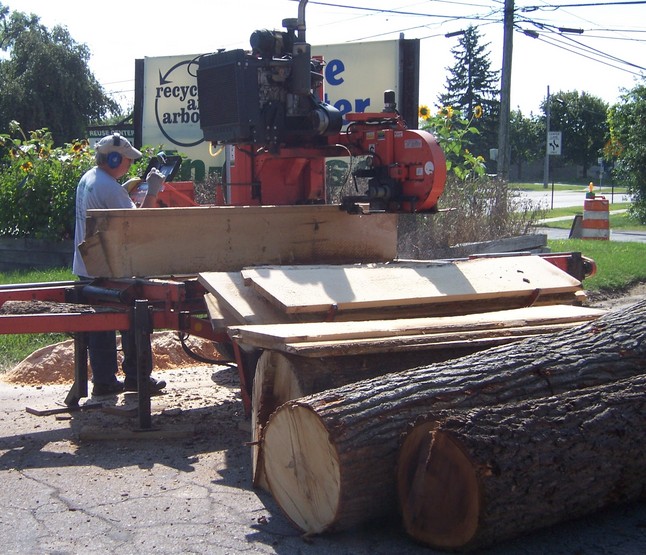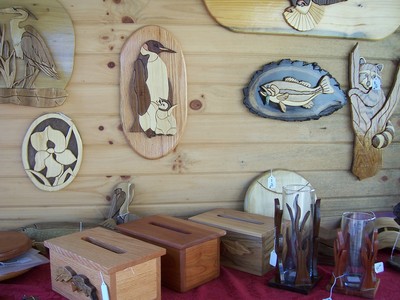New life for dead trees: Urbanwood Project finds purpose in wood destined for scrapheap

Visitors to Recycle Ann Arbor's ReUse Center Saturday had the chance to see a Wood-mizer portable sawmill in action.
Lisa Carolin | For AnnArbor.com
"This is what you can do with recycled wood instead of burning it," Tervol said Saturday as she displayed carved animals, simple boxes and the aforementioned lazy Susans.

Some of the artwork created by Dianna Tervol from Tervol's Wood Products on display at Sawmill Day at the Recycle Ann Arbor ReUse Center Saturday.
Lisa Carolin | AnnArbor.com
Saturday's event included the demonstration of a portable sawmill.
"At first glance, it's just very cool to see a sawmill operating in the middle of Ann Arbor," said Jessica Simons, coordinator of the Urbanwood Project. "Many people have never had the chance to see something like that before."
Tom Peretti, who does woodworking as a hobby, was impressed with what the Wood-Mizer portable sawmill from Tervol's Wood Products could do.
"It's creating beautiful boards," said Peretti, who agrees with the Urbanwood Project's philosophy. "I would rather use wood from a tree that had to be cut down."
Bob Baird and Rick Weid heard about Sawmill Day at their woodworking class at Washtenaw Community College.
"I read how they're able to use ash trees and have a casual interest," said Baird.
"We're taking advantage of a wasted resource," said Kelvin Potter, owner of Raven Farm Recycled Woodworks, an Urbanwood Project partner in Lansing, who says that the industry is turning more to using smaller logs. ""We take it one step further by salvaging material that doesn't fit industry standards."
Milling urban trees is labor intensive and time consuming because the trees must be sorted from other urban wood waste, cut to a workable size, scanned for metal and defects, and processed in small batches so the unique wood can be brought to its full potential.
Simons said, "Most people think of a dead yard tree as simply a source for firewood. Thanks to the Urbanwood Project, it could become your next kitchen table. Even if a tree is killed by something like the emerald ash borer, the wood is often still of very high quality."
The Urbanwood Project began in 2006 as part of Recycle Ann Arbor and the Southeast Michigan Resource Conservation and Development Council's efforts to help communities affected by the emerald ash borer. Logs recovered from southeastern Michigan's communities could produce enough lumber to build 5,600 homes a year according to Michigan State University's Department of Forestry.
Rather than let the logs become firewood or mulch, the Urbanwood Project reclaims the wood for higher-value uses. Simons calls the operation at the ReUse Center "the local farmers' market for wood."


Comments
Barzoom
Mon, Aug 19, 2013 : 12:34 p.m.
A great idea. I hope they're successful.
Angela Todd
Sun, Aug 18, 2013 : 4:06 p.m.
Years ago, when I resided on a certain street, in another city, about 45 minutes or less from Ann Arbor, all of the residents in that city were told that the dead ash trees, infested with the ash tree borer, could not be used for anything, not even mulch. The trees were to be burned somewhere, as I remember. I don't remember how the burning was done to avoid air pollution. Anyway, every tree on our street was cut down, after one infected tree was so weakened that it FELL on a house, doing considerable damage. Only trees that had no "bugs" could be used. It was said that there were treatments to kill the insects of an infested tree, but those treatments were horribly expensive. I wondered, at the time, how you could kill the bugs once they had a firm hold on the trees. The borers lived under the bark. Also, if you were able to successfully kill the bugs in one tree, could you really kill all of them when there were MANY trees together to treat? You would have to treat alll of the trees at the same time. The cost would be phenomenal. Also, if you were able to rid all of the trees of the bugs, what's to say that they wouldn't be re-infested by NEW bugs, constantly coming in from other neighborhoods? If anyone can tell me how the bugs can be killed on a wide scale, I'd love to hear it. However, I am all for the recycling of dead wood, if it is not infested with disease or bugs that would be re-located to a new neighborhood where a new infestation would begin. Gathering the city's diseased or infested wood and burning it all was what the city was told to do. Angela Todd, Ann Arbor resident.
Themadcatter
Sun, Aug 18, 2013 : 3:44 a.m.
When my ash tree succumbed to the ash borer I had hoped to have it rendered into useful boards. But, alas, its circumference was too large and the first limb too low to be cut by the portable saw.
leaguebus
Sun, Aug 18, 2013 : 2:10 a.m.
There is going to be lots of Maple in the next few years, hopefully the dead trees have some value and can help defray the cost of a new tree.
Mike
Sun, Aug 18, 2013 : 7:17 p.m.
Ann Arbor has many dying or dead trees in the right of ways in Ann Arbor subdivisions, Many of these are maple trees, The question: Is the city on board with cutting these trees so that the mill can use them? Could a mill like this produce lumber at a cost that is beneficial to the consumer? Mills of this type are often set up for demonstration and seldom generate a profit from basic lumber. It is easy to say that recovered trees could produce lumber for 5,600 homes, but at what cost to produce the lumber? Saw mills use a source of power that is much more economical then a gas or diesel powered engine. The supply mechanisms to the saws are much faster and more accurate. I do like the idea, So why not sell timber to the mills that can produce quality lumber at a competitive cost ?
social conscience
Sun, Aug 18, 2013 : 1:14 p.m.
Maple? Not aware of any pest or pathogen causing significant mortality in Acer spp. like the emerald ash borer in Fraxinus spp. in the A2 area. Please advise.
Townspeak
Sat, Aug 17, 2013 : 9:01 p.m.
I love this story
Mike
Sat, Aug 17, 2013 : 8:40 p.m.
They've got some real nice pieces of wood if you're looking for a mantel or material for a piece of furniture